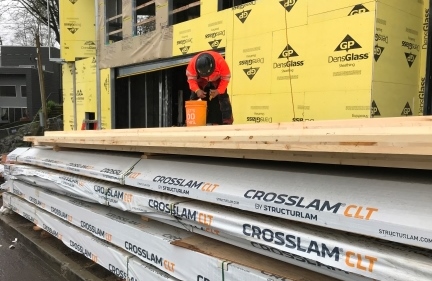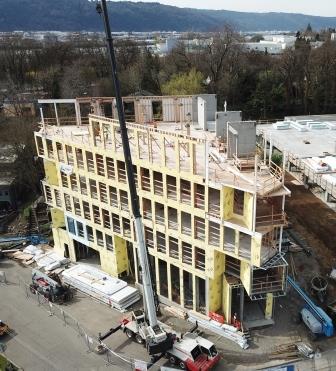

Printable PDF version
Subscribe to our newsletter
Mass Timber Construction
AI in Construction
Tariffs & Escalation
Construction
Management Specialists
111 Pine Street, Suite 1315
San Francisco, CA 94111
(415) 981-9430 (San Francisco office)
6518 Lonetree Blvd., Suite 164
Rocklin, CA 95765
(916) 742-1770 (Sacramento office)
8910 University Center Lane, Suite 1100
San Diego, CA 92123
(619) 814-6793 (San Diego office)
8538 173rd Avenue NE
Redmond, WA 98052
(206) 571-0128 (Seattle office)
2063 Grant Road
Los Altos, CA 94024
(650) 386-1728 (South Bay office)
7083 Hollywood Blvd., 4th Floor
Los Angeles, CA 90028
(424) 343-2652 (Los Angeles, CA office)
78 Heathervue, Greystones
Wicklow, A63Y997, Ireland
+353 86-600-1352 (Europe office)
www.TBDconsultants.com
Anyone in the construction industry will have likely felt the growing media attention and news stories revolving around mass timber. This is due to the growing use and applications that mass timber has in the AEC industry. Mass timber is a term that describes large sections of engineered lumber composed of smaller dimensional lumber or billets. These smaller sections of dimensional lumber make up beams, columns, and panels which make up different types of mass timber products. The products include a soup of acronyms (CLT, DLT, NLT, GLT, MPP, etc.) all of which have their own advantages, disadvantages, suppliers, and limitations.

Photo credit: DCI Engineers
The rock star of the group that is getting the most media attention is Cross Laminated Timber (CLT). The name comes from the process by which it is made. Similar to glue laminated timber products, CLT stacks readily available 2x4 and 2x6 lumber side by side to form a single layer. These layers are then pressed into other layers which cross orthogonally to one another, to form larger panels ranging anywhere from just under 4” thick up to 20” thick and come in widths of 4 feet to 12 feet and are up to 30 feet to 60 feet long, or sometimes longer.
The manufacturing process of CLT is what sets it apart from other types of mass timber products. The orthogonal layers provide an elite dimensional tolerance of an eighth of an inch. CLT panels can also span in both directions due to the strong and weak axis layers of 2x4 and 2x6 lumber, making cross laminated timber a structurally ubiquitous material which can take shear, bending, compression and tension. CLT panels can be used in floor, wall, and roof applications and the number of suppliers in North America has grown from only 2 certified suppliers in 2011 to potentially 7 CLT suppliers by the early part of 2019 (Structurlam, Smartlam, Nordic, DR Johnson, International Beams, Katerra, and Vaagan Lumber).

Photo credit: DCI Engineers
Kris Sprickler is extremely familiar with the North American mass timber market. His team at Structurlam is responsible for completing some of the first mass timber structures in North America, including one of the tallest mass timber structures in the world, Brock Commons, an 18 story project in British Columbia. Kris has seen the amount of mass timber projects grow to over 200 projects per year in North America. “We are seeing a huge increase in our production,” he says, “as the majority of clients want a more robust product that is renewable and increases construction speed and accuracy on site. Our goal is to deliver a better overall product, which is faster and more cost effective.” The recent tariffs have put some markets in a precarious situation when it comes to international trade. However, Spickler states that due to long term purchasing agreements, engineered wood products, such as CLT are able to keep a more stable price in the market.
From a contractor’s standpoint, mass timber holds equally advantageous attributes. Lendlease, a leading international development and construction group with operations in Australia, Asia, Europe and the Americas, has pioneered the use of cross-laminated timber (CLT) around the globe, including the successful delivery of the first all-CLT hotel in the United States. With over 1,100 units in design, pre-construction or completed, Lendlease’s CLT experience has demonstrated several important advantages: faster construction schedules, thus reducing carrying costs for owners; smaller crews assembling the structures in less time and in a safer manner; on-time delivery of materials, minimized community disruption during construction; precision and installed dimensional reliability which creates more opportunity for other trades to implement off-site prefabrication as well; and environmental sustainability. Andy Holst, a Senior Project Manager for Lendlease, is keen on the idea of integrating mass timber into structures where it makes sense. “If we were to look at a multi-family project we can increase the amount of productivity by 20% to 30% with the use of a mass timber panel as the floor assembly while still keeping the wood stud walls for gravity support. The speed of construction lends itself in markets with a tight labor market with higher than average wages,” says Andy.
Jacob Artier, from the Northern California Carpenters Union, is well aware of the innovation that mass timber brings to the construction market. “We want the carpenters union to be at the forefront of this technology. We are an active participant and supporter of new construction delivery methods and factory built modular construction in the northern California markets. As evolution continues in our industry we intend to be a part of it and make sure our membership grows with it.”
From a structural perspective, DCI Engineers sees mass timber as an extremely viable product in certain applications. DCI Engineers has mass timber projects throughout the country (stretching from Alaska to Texas). In the past three years DCI has had almost 30 projects that utilize some form of mass timber. The most common thus far has been the use of mass timber products for floor and roof applications. Mass timber floors have the possibility of being less than half the weight of traditional type I concrete floor structures. The reduced weight offers a significant amount of savings in terms of cost for the seismic system, which can be designed for a lower amount of force in an earthquake given a lower amount of seismic mass and weight. CLT walls are not as viable in seismic regions as the structural proposals for platform framed CLT structures need to be formalized into the building code so they can be applied without an alternative means and methods request. Updated code provisions for CLT shear walls are aiming to be adopted in the 2021 IBC which will also see a significant change to mass timber building types.

Photo credit: Lendlease
Currently mass timber is allowed in roofs for type I and type II buildings as well as type III, type IV, and type V construction for structures under 85 feet. Mass timber products can be used in instances for type I structures and can also be more aggressively pursued for projects if they seek an alternate means and methods. However the code constraints which currently affect mass timber may be changing. Currently there are proposals before the International Code Council (ICC) to adopt the allowance of 9, 12, and 18 story mass timber structures in the 2021 International Building Code (IBC). The state of Oregon has already enacted a state wide amendment to their building code which adopts the provisions for 9, 12, and 18 story buildings.
There are a lot of people who are excited by the idea of high rise mass timber structures up to 60 stories or greater. However, buildings above 15 floors represent less than 2% of the construction market. The real goal should be to get mass timber into the general market and this is exactly what the code proposals for the 9, 12, and 18 story options will provide. With a growing constraint on the markets labor force and a trend toward sustainable buildings and renewable materials, the new code proposals could come at an opportune time to provide other options to the construction industry.
Dean Lewis, DCI Engineers
Artificial Intelligence has been talked about for decades, but it had been looking as if it would never really arrive. But now it is finding it's way into industry and commerce, and even our private lives. Here we look at how it is starting to affect the construction industry.
Tariffs are making the news regularly these days, and here we look at the effects they are having on the construction bidding market.
Design consultant: Katie Levine of Vallance, Inc.